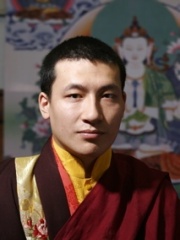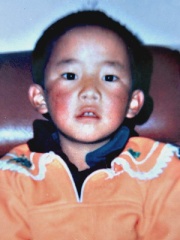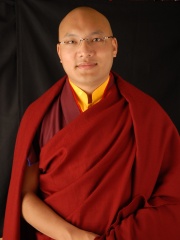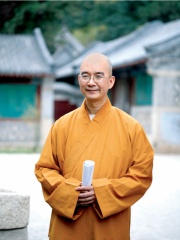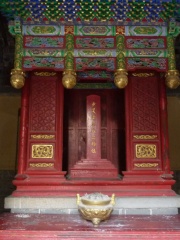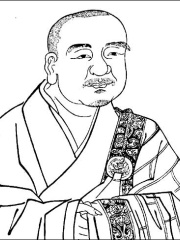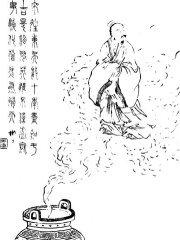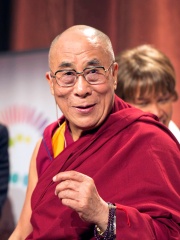
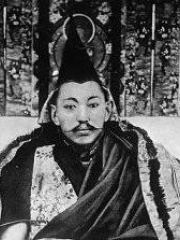
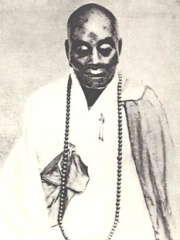
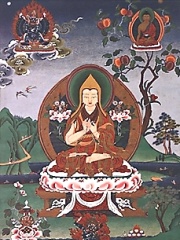
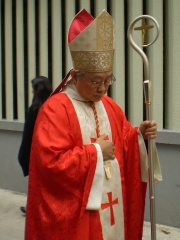
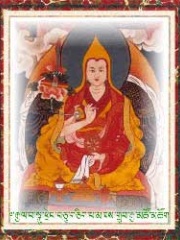
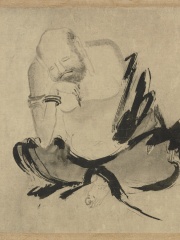
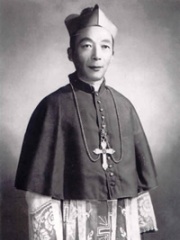
The Most Famous
RELIGIOUS FIGURES from China
This page contains a list of the greatest Chinese Religious Figures. The pantheon dataset contains 3,187 Religious Figures, 26 of which were born in China. This makes China the birth place of the 19th most number of Religious Figures behind Japan, and Switzerland.
Top 10
The following people are considered by Pantheon to be the top 10 most legendary Chinese Religious Figures of all time. This list of famous Chinese Religious Figures is sorted by HPI (Historical Popularity Index), a metric that aggregates information on a biography's online popularity. Visit the rankings page to view the entire list of Chinese Religious Figures.

1. 14th Dalai Lama (b. 1935)
With an HPI of 83.17, 14th Dalai Lama is the most famous Chinese Religious Figure. His biography has been translated into 118 different languages on wikipedia.
The 14th Dalai Lama (born Lhamo Thondup; 6 July 1935; full spiritual name: Jetsun Jamphel Ngawang Lobsang Yeshe Tenzin Gyatso, shortened as Tenzin Gyatso) is the incumbent Dalai Lama, the highest spiritual leader and head of Tibetan Buddhism. He served as the resident spiritual and temporal leader of Tibet before 1959 and subsequently led the Tibetan government in exile represented by the Central Tibetan Administration in Dharamsala, India. A belief central to the Tibetan Buddhist tradition as well as the institution of the Dalai Lama is that the reincarnated person is a living Bodhisattva, specifically an emanation of Avalokiteśvara (in Sanskrit) or Chenrezig (in Tibetan), the Bodhisattva of Compassion. The Mongolic word dalai means ocean. The 14th Dalai Lama is also known to Tibetans as Gyalwa Rinpoche ("The Precious Jewel-like Buddha-Master"), Kundun ("The Presence"), and Yizhin Norbu ("The Wish-Fulfilling Gem"). His devotees, as well as much of the Western world, often call him His Holiness the Dalai Lama. He is the leader and a monk of the newest Gelug school of Tibetan Buddhism. The 14th Dalai Lama was born to a farming family in Taktser (Hongya village), in the traditional Tibetan region of Amdo, at the time a Chinese frontier district. He was selected as the tulku of the 13th Dalai Lama in 1937, and formally recognised as the 14th Dalai Lama in 1939. As with the recognition process for his predecessor, a Golden Urn selection process was waived and approved by the Nationalist government of China. His enthronement ceremony was held in Lhasa on 22 February 1940. Following the Battle of Chamdo, in which PRC forces annexed Central Tibet, the Tibetan government, the Ganden Phodrang, invested the Dalai Lama with temporal duties on 17 November 1950 (at 15 years of age), which he held until his exile in 1959. During the 1959 Tibetan uprising, the Dalai Lama escaped to India, where he continues to live. On 29 April 1959, the Dalai Lama established the independent Tibetan government in exile in the north Indian hill station of Mussoorie, which then moved in May 1960 to Dharamshala, where he resides. He retired as political head in 2011 to make way for a democratic government, the Central Tibetan Administration. The Dalai Lama advocates for the welfare of Tibetans and since the early 1970s has called for the Middle Way Approach with China to peacefully resolve the issue of Tibet. This policy, adopted democratically by the Central Tibetan Administration and the Tibetan people through long discussions, seeks to find a middle ground, "a practical approach and mutually beneficial to both Tibetans and Chinese, in which Tibetans can preserve their culture and religion and uphold their identity," and China's assertion of sovereignty over Tibet, aiming to address the interests of both parties through dialogue and communication and for Tibet to remain a part of China. He criticised the CIA Tibetan program, saying that its sudden end in 1972 proved it was primarily aimed at serving American interests. Until reaching his mid-80s, the Dalai Lama travelled worldwide to give Tibetan Mahayana and Vajrayana Buddhism teachings, and his Kalachakra teachings and initiations were international events. He also attended conferences on a wide range of subjects, including the relationship between religion and science, met with other world leaders, religious leaders, philosophers, and scientists, online and in-person. Since 2018, he has continued to teach on a reduced schedule, limiting his travel to within India only, and occasionally addressing international audiences via live webcasts. His work includes focus on the environment, economics, women's rights, nonviolence, interfaith dialogue, physics, astronomy, Buddhism and science, cognitive neuroscience, reproductive health and sexuality. The Dalai Lama was awarded the Nobel Peace Prize in 1989. Time magazine named the Dalai Lama Gandhi's spiritual heir to nonviolence. The 12th General Assembly of the Asian Buddhist Conference for Peace in New Delhi unanimously recognised the Dalai Lama's contributions to global peace, his lifelong efforts in uniting Buddhist communities worldwide, and bestowed upon him the title of "Universal Supreme Leader of the Buddhist World"; they also designated 6 July, his birthday, as the Universal Day of Compassion. In addition in India, MP delgation led by Sujeet Kumar, Member of Parliament, Rajya Sabha has advocated for Bharat Ratna, the highest civilian honour for Dalai Lama.

2. 13th Dalai Lama (1876 - 1933)
With an HPI of 73.53, 13th Dalai Lama is the 2nd most famous Chinese Religious Figure. His biography has been translated into 53 different languages.
The 13th Dalai Lama, Thubten Gyatso (full given name: Ngawang Lobsang Thupten Gyatso Jigdral Chokley Namgyal; Tibetan: ཐུབ་བསྟན་རྒྱ་མཚོ་, Wylie: Thub Bstan Rgya Mtsho; Chinese: 罗布藏塔布开甲木措; pinyin: Luóbùzàng Tǎbùkāi Jiǎmùcuò); 12 February 1876 – 17 December 1933) was the 13th Dalai Lama of Tibet, enthroned during a turbulent modern era. He presided during the collapse of the Qing dynasty, and is referred to as "the Great Thirteenth", responsible for redeclaring Tibet's national independence, and for his national reform and modernization initiatives. In 1878, he was recognized as the reincarnation of the Dalai Lama. He was escorted to Lhasa and given his pre-novice vows by the Panchen Lama, Tenpai Wangchuk, and given the name "Ngawang Lobsang Thupten Gyatso Jigdral Chokley Namgyal". In 1879, he was enthroned at the Potala Palace, but did not assume political power until 1895, after he had reached his maturity. Thubten Gyatso was an intellectual reformer and skillful politician. He was responsible for rebuilding Tibet's geopolitical position after the British expedition to Tibet, restoring discipline in monastic life, and increasing the number of lay officials to avoid excessive power being placed in the hands of the monks.

3. Huineng (638 - 713)
With an HPI of 71.02, Huineng is the 3rd most famous Chinese Religious Figure. His biography has been translated into 30 different languages.
Dajian Huineng or Hui-neng (traditional Chinese: 大鑒惠能; pinyin: Dàjiàn Huìnéng; Cantonese Jyutping: daai6 gaam3 wai6 nang4; Wade–Giles: Ta⁴-chien⁴ Hui⁴-nêng²; Japanese: Daikan Enō; Korean: Daegam Hyeneung; February 27, 638 – August 28, 713), also commonly known as the Sixth Patriarch or Sixth Ancestor of Chan (traditional Chinese: 禪宗六祖), is a semi-legendary but central figure in the early history of Chinese Chan Buddhism. According to tradition Huineng was an uneducated layman who suddenly attained awakening (Chinese: 見性, jianxing) upon hearing the Diamond Sutra. Despite his lack of formal training, he demonstrated his understanding to the fifth patriarch, Daman Hongren, who then supposedly chose Huineng as his true successor instead of his publicly known selection of Yuquan Shenxiu. Huineng is regarded as the founder of the "Sudden Enlightenment" Southern Chan school of Buddhism, which focuses on an immediate and direct attainment of Buddhist enlightenment. The Platform Sutra of the Sixth Patriarch (六祖壇經), which is said to be a record of his teachings, is a highly influential text in the East Asian Buddhist tradition. 20th century scholarship revealed that the story of Huineng's Buddhist career was likely invented by the monk Shenhui, who claimed to be one of Huineng's disciples and was highly critical of Shenxiu's teaching.

4. Je Tsongkhapa (1357 - 1419)
With an HPI of 70.56, Je Tsongkhapa is the 4th most famous Chinese Religious Figure. His biography has been translated into 33 different languages.
Tsongkhapa (Tibetan: ཙོང་ཁ་པ་, [tsoŋˈkʰapa], meaning: "the man from Tsongkha" or "the Man from Onion Valley", c. 1357–1419) was an influential Tibetan Buddhist monk, philosopher and tantric yogi, whose activities led to the formation of the Gelug school of Tibetan Buddhism. His philosophical works are a grand synthesis of the Buddhist epistemological tradition of Dignāga and Dharmakīrti, the Cittamatra philosophy of the mind, and the madhyamaka philosophy of Nāgārjuna and Candrakīrti. Central to his philosophical and soteriological teachings is "a radical view of emptiness" which sees all phenomena as devoid of intrinsic nature. This view of emptiness is not a kind of nihilism or a total denial of existence. Instead, it sees phenomena as existing "interdependently, relationally, non-essentially, conventionally" (which Tsongkhapa terms "mere existence"). Tsongkhapa emphasized the importance of philosophical reasoning in the path to liberation. According to Tsongkhapa, meditation must be paired with rigorous reasoning in order "to push the mind and precipitate a breakthrough in cognitive fluency and insight."
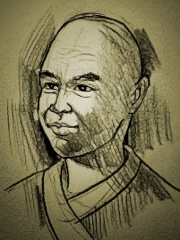
5. Yijing (635 - 713)
With an HPI of 67.50, Yijing is the 5th most famous Chinese Religious Figure. His biography has been translated into 25 different languages.
Yijing (635–713 CE), formerly romanized as I-ching or I-tsing, born Zhang Wenming, was a Tang-era Chinese Buddhist monk and renowned travel writer. His account of his travels are an important source for the history of the medieval kingdoms along the sea route between China and India, especially Srivijaya in Indonesia. He also gave accounts of the Gupta Period in ancient India. A student of the Buddhist university at Nālandā (now in Bihar, India), he was also responsible for the translation of many Buddhist texts from Sanskrit and Pali into Chinese.

6. Joseph Zen (b. 1932)
With an HPI of 66.29, Joseph Zen is the 6th most famous Chinese Religious Figure. His biography has been translated into 28 different languages.
Joseph Zen Ze-kiun, SDB (Chinese: 陳日君 , born 13 January 1932) is a Chinese Catholic prelate who served as Bishop of Hong Kong from 2002 to 2009. He was made a cardinal by Pope Benedict XVI in 2006 and has been outspoken on issues regarding human rights, political freedom, and religious liberty. He is a member of the Salesians of Don Bosco. Zen's strong ties with Hong Kong's pro-democracy camp often attract criticism from the pro-Beijing camp and the government of China. Zen retired on 15 April 2009, but remains a strong pro-democracy influence in Hong Kong. On 11 May 2022, he was arrested by the National Security Police and later that day released on bail.

7. 11th Dalai Lama (1838 - 1856)
With an HPI of 65.48, 11th Dalai Lama is the 7th most famous Chinese Religious Figure. His biography has been translated into 39 different languages.
The 11th Dalai Lama, Khedrup Gyatso (1 November 1838 – 31 January 1856) was recognized by the Ganden Tripa as the 11th Dalai Lama of Tibet and enthroned in 1842. He enlarged the Norbulingka, studied at Sera Monastery, Drepung Monastery and Ganden Monastery, and taught students. He was recognised as the 11th Dalai Lama in 1841, after being born in Garthang near Dartsedo, the same village where the 7th Dalai Lama, Kelzang Gyatso was born in 1708. He was taken to Lhasa and in 1842, the 7th Panchen Lama, Lobzang Tenpai Nyima, gave him refuge vows, cut his hair and gave him the name of Khedrup Gyatso. In 1842, he was enthroned as the 11th Dalai Lama in the Potala Palace on the Full Moon day of the 4th Lunar month (24 May 1842). In 1846 he became a preliminary monk (rab byung), and in 1848 at the age of eleven years he took the getsul novice vows of monkhood, while both were bestowed by the 7th Panchen Lama He had a residence at the Norbulingka built in 1848, and participated in the annual Zhoton summer festival in Lhasa, while also traveling on pilgrimage to Samye Monastery, Mount Kailash and its Lake Manasarovar, and to other places. He gave public audiences, taught, and stood for his examinations in 1852 and 1853, and passed. He wrote a book of stanzas, Story of the Monkeys and Birds (Bya sprel gyi gtam-rgyud). It is an allegory of the war at the end of the 18th century between the Tibetans and the Gurkhas ('birds' and 'monkeys' respectively). He assumed political leadership on the request of Daoguang Emperor in 1855 but died less than one year later on 31 January 1856, becoming the third successive Dalai Lama who died at a young age. "During the period of the short-lived Dalai Lamas—from the Ninth to the Twelfth incarnations—the Panchen Lama was the lama of the hour, filling the void left by the four Dalai Lamas who died in their youth."

8. Dazu Huike (487 - 593)
With an HPI of 65.13, Dazu Huike is the 8th most famous Chinese Religious Figure. His biography has been translated into 16 different languages.
Dazu Huike (487–593; Chinese: 大祖慧可; pinyin: Dàzǔ Huìkě; Wade–Giles: Ta-tsu Hui-k'o; Japanese pronunciation: Taiso Eka) is considered the Second Patriarch of Chan Buddhism and the twenty-ninth since Gautama Buddha. He was the successor to Bodhidharma.

9. Ignatius Kung Pin-Mei (1901 - 2000)
With an HPI of 64.38, Ignatius Kung Pin-Mei is the 9th most famous Chinese Religious Figure. His biography has been translated into 23 different languages.
Ignatius Kung Pin-Mei (simplified Chinese: 龚品梅; traditional Chinese: 龔品梅; pinyin: Gōng Pǐnméi; Wade–Giles: Kung P'in-mei; 2 August 1901 – 12 March 2000) was a Chinese Catholic prelate who served as Bishop of Shanghai from 1950 until his death in 2000. He spent 30 years in prison for defying attempts by the Chinese Communist Party (CCP) to control Catholics in the country through the government-approved Chinese Catholic Patriotic Association. At the time of his death in exile in the United States, he was the oldest member of the College of Cardinals, to which he was secretly appointed by Pope John Paul II in 1979.
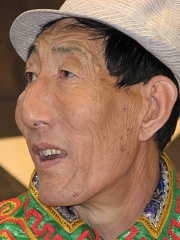
10. Bao Xishun (b. 1951)
With an HPI of 64.37, Bao Xishun is the 10th most famous Chinese Religious Figure. His biography has been translated into 24 different languages.
Bao Xishun (also known as Xi Shun; born November 2, 1951) is a Chinese herdsman from Chifeng, Inner Mongolia, recognized by Guinness World Records as one of the world's tallest living men at 7 feet 9 inches (236 cm) tall. He was formerly certified as the tallest living man by the Guinness World Records. On September 17, 2009, Sultan Kösen overtook Bao Xishun as the tallest living man.
People
Pantheon has 26 people classified as Chinese religious figures born between 101 and 1989. Of these 26, 7 (26.92%) of them are still alive today. The most famous living Chinese religious figures include 14th Dalai Lama, Joseph Zen, and Bao Xishun. The most famous deceased Chinese religious figures include 13th Dalai Lama, Huineng, and Je Tsongkhapa.
Living Chinese Religious Figures
Go to all Rankings14th Dalai Lama
1935 - Present
HPI: 83.17
Joseph Zen
1932 - Present
HPI: 66.29
Bao Xishun
1951 - Present
HPI: 64.37
Trinley Thaye Dorje
1983 - Present
HPI: 48.47
Gedhun Choekyi Nyima
1989 - Present
HPI: 48.29
Ogyen Trinley Dorje
1985 - Present
HPI: 47.90
Xuecheng
1966 - Present
HPI: 44.03
Deceased Chinese Religious Figures
Go to all Rankings13th Dalai Lama
1876 - 1933
HPI: 73.53
Huineng
638 - 713
HPI: 71.02
Je Tsongkhapa
1357 - 1419
HPI: 70.56
Yijing
635 - 713
HPI: 67.50
11th Dalai Lama
1838 - 1856
HPI: 65.48
Dazu Huike
487 - 593
HPI: 65.13
Ignatius Kung Pin-Mei
1901 - 2000
HPI: 64.38
Shaohao
HPI: 63.86
Rabban Bar Sauma
1220 - 1294
HPI: 63.40
Jianzhen
688 - 763
HPI: 62.47
Sengcan
529 - 606
HPI: 62.37
Gan Ji
101 - 200
HPI: 61.45
Overlapping Lives
Which Religious Figures were alive at the same time? This visualization shows the lifespans of the 9 most globally memorable Religious Figures since 1700.

